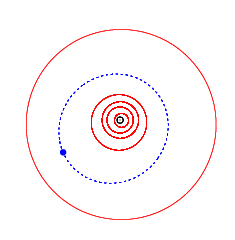Astronomy:9936 Al-Biruni
 Orbit of Al-Biruni (blue) compared to the inner planets and Jupiter (outermost) | |
| Discovery [1] | |
|---|---|
| Discovered by | E. W. Elst V. Ivanova |
| Discovery site | Rozhen Obs. |
| Discovery date | 8 August 1986 |
| Designations | |
| (9936) Al-Biruni | |
| Pronunciation | /ælbɪˈruːni/[4] |
| Named after | البيروني al-Bīrūnī (Persian astronomer)[2] |
| 1986 PN4 · 1981 UV12 | |
| Minor planet category | main-belt · (outer)[3] |
| Orbital characteristics [1] | |
| Epoch 4 September 2017 (JD 2458000.5) | |
| Uncertainty parameter 0 | |
| Observation arc | 35.62 yr (13,009 days) |
| |{{{apsis}}}|helion}} | 3.6534 AU |
| |{{{apsis}}}|helion}} | 2.5107 AU |
| 3.0820 AU | |
| Eccentricity | 0.1854 |
| Orbital period | 5.41 yr (1,976 days) |
| Mean anomaly | 279.59° |
| Mean motion | 0° 10m 55.92s / day |
| Inclination | 15.404° |
| Longitude of ascending node | 310.41° |
| 13.774° | |
| Physical characteristics | |
| Dimensions | 22.16 km (calculated)[3] 23.890±0.170[5] 24.187±0.314 km[6] 27.81±1.61 km[7] |
| Rotation period | 10.704±0.010 h[8] |
| Geometric albedo | 0.048±0.006[7] 0.057 (assumed)[3] 0.0632±0.0151[6] 0.065±0.012[5] |
| C [3] | |
| Absolute magnitude (H) | 12.1[1] · 11.7[6][7] · 12.0[3] |
9936 Al-Biruni, provisional designation 1986 PN4, is a carbonaceous asteroid from the outer region of the asteroid belt, approximately 24 kilometers in diameter. It was discovered on 8 August 1986, by Belgian and Bulgarian astronomers Eric Elst and Violeta Ivanova at the Rozhen Observatory, located in Bulgaria's Smolyan province near the border to Greece.[9] It was named for Persian medieval scholar Al-Biruni.[2]
Orbit and classification
Al-Biruni orbits the Sun in the outer main-belt at a distance of 2.5–3.7 AU once every 5 years and 5 months (1,976 days). Its orbit has an eccentricity of 0.19 and an inclination of 15° with respect to the ecliptic.[1] It was first identified as 1981 UV12 at Crimea-Nauchnij in 1981, extending the body's observation arc by 5 years prior to its official discovery at Rozhen.[9]
Lightcurve
A rotational lightcurve of Al-Biruni was obtained from photometric observations made at the U.S. Goodsell Observatory (741), Minnesota, in August 2002. The lightcurve gave a rotation period of 10.704±0.010 hours with a brightness amplitude of 0.14 in magnitude ({{{1}}})[8]
Diameter and albedo
According to the space-based surveys carried out by the Japanese Akari satellite and the NEOWISE mission of NASA's Wide-field Infrared Survey Explorer, Al-Biruni measures between 23.9 and 27.8 kilometers in diameter, and its surface has a corresponding albedo of 0.048 to 0.065.[5][6][7] The Collaborative Asteroid Lightcurve Link assumes a standard albedo for carbonaceous asteroids of 0.057 and calculates a diameter of 22.2 kilometers with an absolute magnitude of 12.0.[3]
Naming
The minor planet was named after the Persian scholar and polymath Al-Biruni (973–1048). Regarded as the founder of Indology and the father of geodesy, he made important contributions to anthropology, mathematics and astronomy. In particular, he is known for developing a method for the summation of series, for solving algebraic equations, and for the triangulation of distances on Earth's surface.[2] The official naming citation was published by the Minor Planet Center on 26 September 2007 (M.P.C. 60728).[10] The lunar crater Al-Biruni is also named in his honour.
References
- ↑ 1.0 1.1 1.2 1.3 "JPL Small-Body Database Browser: 9936 Al-Biruni (1986 PN4)". Jet Propulsion Laboratory. https://ssd.jpl.nasa.gov/sbdb.cgi?sstr=2009936.
- ↑ 2.0 2.1 2.2 Schmadel, Lutz D. (2003). Dictionary of Minor Planet Names – (9936) Al-Biruni. Springer Berlin Heidelberg. p. 712. ISBN 978-3-540-29925-7. https://books.google.com/books?id=aeAg1X7afOoC&pg=PA712. Retrieved 13 May 2016.
- ↑ 3.0 3.1 3.2 3.3 3.4 3.5 "LCDB Data for (9936) Al-Biruni". Asteroid Lightcurve Database (LCDB). http://www.minorplanet.info/PHP/generateOneAsteroidInfo.php?AstInfo=9936%7CAl-Biruni.
- ↑ The McGraw-Hill Encyclopedia of World Biography (1973)
- ↑ 5.0 5.1 5.2 Masiero, Joseph R.; Mainzer, A. K.; Grav, T.; Bauer, J. M.; Cutri, R. M.; Dailey, J. et al. (November 2011). "Main Belt Asteroids with WISE/NEOWISE. I. Preliminary Albedos and Diameters". The Astrophysical Journal 741 (2): 20. doi:10.1088/0004-637X/741/2/68. Bibcode: 2011ApJ...741...68M. http://adsabs.harvard.edu/cgi-bin/bib_query?bibcode=2011ApJ...741...68M. Retrieved 4 December 2016.
- ↑ 6.0 6.1 6.2 6.3 Mainzer, A.; Grav, T.; Masiero, J.; Hand, E.; Bauer, J.; Tholen, D. et al. (November 2011). "NEOWISE Studies of Spectrophotometrically Classified Asteroids: Preliminary Results". The Astrophysical Journal 741 (2): 25. doi:10.1088/0004-637X/741/2/90. Bibcode: 2011ApJ...741...90M. http://adsabs.harvard.edu/cgi-bin/bib_query?bibcode=2011ApJ...741...90M. Retrieved 13 May 2016.
- ↑ 7.0 7.1 7.2 7.3 Usui, Fumihiko; Kuroda, Daisuke; Müller, Thomas G.; Hasegawa, Sunao; Ishiguro, Masateru; Ootsubo, Takafumi et al. (October 2011). "Asteroid Catalog Using Akari: AKARI/IRC Mid-Infrared Asteroid Survey". Publications of the Astronomical Society of Japan 63 (5): 1117–1138. doi:10.1093/pasj/63.5.1117. Bibcode: 2011PASJ...63.1117U. (online, AcuA catalog p. 153)
- ↑ 8.0 8.1 Clark, Maurice; Joyce, Brian (December 2002). "Asteroid lightcurve photometry from Goodsell Observatory (741)". The Minor Planet Bulletin 30 (1): 4–7. ISSN 1052-8091. Bibcode: 2003MPBu...30....4C. http://adsabs.harvard.edu/cgi-bin/bib_query?bibcode=2003MPBu...30....4C. Retrieved 18 December 2015.
- ↑ 9.0 9.1 "9936 Al-Biruni (1986 PN4)". Minor Planet Center. https://www.minorplanetcenter.net/db_search/show_object?object_id=9936.
- ↑ "MPC/MPO/MPS Archive". Minor Planet Center. https://www.minorplanetcenter.net/iau/ECS/MPCArchive/MPCArchive_TBL.html.
External links
- Rozhen Observatory, Smolyan, Bulgaria
- Asteroid Lightcurve Database (LCDB), query form (info )
- Dictionary of Minor Planet Names, Google books
- Asteroids and comets rotation curves, CdR – Observatoire de Genève, Raoul Behrend
- Discovery Circumstances: Numbered Minor Planets (5001)-(10000) – Minor Planet Center
- 9936 Al-Biruni at AstDyS-2, Asteroids—Dynamic Site
- 9936 Al-Biruni at the JPL Small-Body Database
 |

